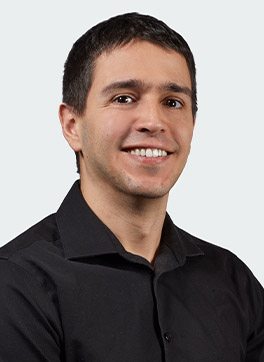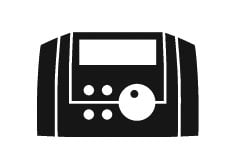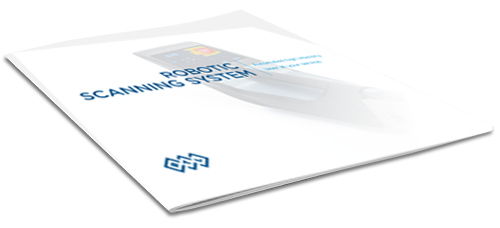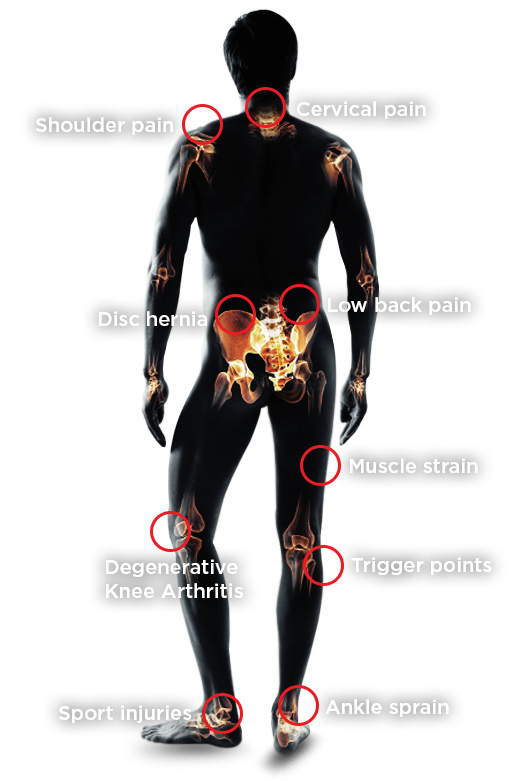Login / Create account as a healthcare professional to unlock additional discounts on most products.
BTL HIGH INTENSITY LASER: A HANDSFREE SOLUTION FOR EFFECTIVE HEALING
The BTL-6000 High Intensity Laser (HIL) is the first Robotic Intelligent Scanning System with the highest power approved by Health Canada. Its power of 10 Watts and ideal wavelength of 1064nm allow for effective light penetration deep into the tissues. The BTL HIL offers a powerful form of pain management, healing, and regeneration through a natural process of energy transfer. It’s effective in the treatment of a multitude of acute and chronic conditions and sport injuries including muscle strain or joint distortion, arthritis, low back pain & sciatica and impingement syndrome to name a few. Health Canada approved. Medical Device License 80111.
MEDICAL EFFECTS
Pulsed
The analgesic effect of the High Intensity Laser occurs mostly when using the pulsed mode where therapy is delivered in very short pulses at a very high frequency. The pulsed mode has the ability to create actual pressure. The pressure waves are carried through the tissue where they stimulate nerve endings and activate the gate control mechanism of pain relief. The analgesic effect of the High Intensity Laser is instantaneous and long-lasting.
The mechanical waves created by the High Intensity Laser stimulate local microcirculation and lymph drainage of the area being treated. Combining biostimulation and photomechanical stimulation, the High Intensity Laser therapy actually heals the tissue while providing a non-addictive form of pain management.
The energy delivered by the High Intensity Laser speeds up cellular metabolism and increases the speed of resorption of proinflammatory mediators. Decreased concentration of proinflammatory mediators restores capillary permeability and results in elimination of inflammation.
Continuous
The term biostimulation refers to stimulation at the cellular level to facilitate and speed up healing and recovery. Faster exchange of oxygen and metabolites due to laser irradiation causes more oxygen atoms to reach the mitochondria. Mitochondria are further stimulated to increase the synthesis of ATP which leads to faster recovery.
The thermal effect of the High Intensity Laser is caused by the absorption of the 1064 nm wavelength in the superficial tissues. Warming the superficial tissues decreases of scatter and absorption coefficients and allows for even deeper light penetration. Thermal effect also causes vasodilatation. As a result, blood perfusion increases, larger amounts of oxygen are delivered to the tissues and more metabolites are resorbed.
The energy delivered with continuous High Intensity Laser therapy causes superficial hyperthermy in the tissues and consequently vasodilatation. As increased perfusion passes more blood through the treated area, the muscles relax, pain decreases and range of motion is improved.
MECHANISM OF ACTION
TR-Therapy transfers radiofrequency energy through tissue using either capacitive or resistive applicator. Capacitive mode is used to treat superficial structures, such as skin and muscles. Resistive way of application treats deep structures, such as deep muscles, tendons and bones. Due to natural resistivity of the body to radiofrequency energy, TR-Therapy creates pleasant selective healing that spreads through the body. TR-Therapy brings not only scientifically proven medical effects but also a great feeling of being relaxed.
Promp
analgesic effects
Long-term Effect of High Intensity Laser Therapy in the Treatment of Patients With Chronic Low Back Pain: A Randomized Blinded Placebo-controlled Trial
Effective
therapeutic method
Effect of High Intensity Laser Therapy in the Management of Myofascial Pain Syndrome of the Trapezius: A Double-blind, Placebo-controlled Study
Non-invasive
adjuvant treatment
Short-term Effects of High Intensity Laser Therapy on Frozen Shoulder: A Prospective Randomized Control Study

Lease for $3/day
Finance your success and benefit
from advanced technology for
as low as $3/day.
Learn More >

Training & Education
Gain valuable understanding about TR Therapy and application techniques.
FAQ
Yes, it is. However, there are safety measures that must be followed. High Intensity Laser can be dangerous to the eyes, opened or closed. Therapist and patient must therefore wear safety glasses provided by the supplier. Also, the therapy should be performed in a closed room.
No, it’s not. It’s a painless therapy.
Since the application of High Intensity Laser is dynamic, the chance of burns is very low. Automated safety measures are in place when using the optional Intelligent Robotic Scanning System. It includes safe distance monitoring between the system and the patient, temperature monitoring, and a thermal perception scan to determine patient heat threshold.
This depends on the condition, it’s severity and how the body will react to treatment. The number of treatments can range between 5 to 10.
High Intensity Laser can be used daily. A minimum of 2 sessions per week is recommended.

BTL HIGH INTENSITY
CLASS IV LASER:
A HANDSFREE SOLUTION FOR EFFECTIVE HEALING
The BTL-6000 High Intensity Laser (HIL) is the first Robotic Intelligent Scanning System with the highest power approved by Health Canada. Its power of 10-20 Watts and ideal wavelength of 1064nm allow for effective light penetration deep into the tissues. The BTL HIL offers a powerful form of pain management, healing, and regeneration through a natural process of energy transfer. It’s effective in the treatment of a multitude of acute and chronic conditions and sport injuries including muscle strain or joint distortion, arthritis, low back pain & sciatica and impingement syndrome to name a few. Health Canada approved. Medical Device License 80111.
MEDICAL EFFECTS
Pulsed
Continuous
The analgesic effect of the High Intensity Laser occurs mostly when using the pulsed mode where therapy is delivered in very short pulses at a very high frequency. The pulsed mode has the ability to create actual pressure. The pressure waves are carried through the tissue where they stimulate nerve endings and activate the gate control mechanism of pain relief. The analgesic effect of the High Intensity Laser is instantaneous and long-lasting.
The mechanical waves created by the High Intensity Laser stimulate local microcirculation and lymph drainage of the area being treated. Combining biostimulation and photomechanical stimulation, the High Intensity Laser therapy actually heals the tissue while providing a non-addictive form of pain management.
The energy delivered by the High Intensity Laser speeds up cellular metabolism and increases the speed of resorption of proinflammatory mediators. Decreased concentration of proinflammatory mediators restores capillary permeability and results in elimination of inflammation.
The term biostimulation refers to stimulation at the cellular level to facilitate and speed up healing and recovery. Faster exchange of oxygen and metabolites due to laser irradiation causes more oxygen atoms to reach the mitochondria. Mitochondria are further stimulated to increase the synthesis of ATP which leads to faster recovery.
The thermal effect of the High Intensity Laser is caused by the absorption of the 1064 nm wavelength in the superficial tissues. Warming the superficial tissues decreases of scatter and absorption coefficients and allows for even deeper light penetration. Thermal effect also causes vasodilatation. As a result, blood perfusion increases, larger amounts of oxygen are delivered to the tissues and more metabolites are resorbed.
The energy delivered with continuous High Intensity Laser therapy causes superficial hyperthermy in the tissues and consequently vasodilatation. As increased perfusion passes more blood through the treated area, the muscles relax, pain decreases and range of motion is improved.
Analgesic Effect
Based on the gate control mechanism of pain, mechanical stimulation of free nerve endings leads to their inhibition and hence pain relief.
Analgesic Effect
The analgesic effect of the High Intensity Laser occurs mostly when using the pulsed mode where therapy is delivered in very short pulses at a very high frequency. The pulsed mode has the ability to create actual pressure. The pressure waves are carried through the tissue where they stimulate nerve endings and activate the gate control mechanism of pain relief. The analgesic effect of the High Intensity Laser is instantaneous and long-lasting.
Microcirculation Stimulation
High Intensity Laser therapy actually heals the tissue while providing a powerful and non-addictive form of pain management.
Microcirculation Stimulation
The mechanical waves created by the High Intensity Laser stimulate local microcirculation and lymph drainage of the area being treated. Combining biostimulation and photomechanical stimulation, the High Intensity Laser therapy actually heals the tissue while providing a non-addictive form of pain management.
Anti-inflammatory Effect
Energy delivered by the High Intensity Laser speeds up cellular metabolism and causes faster resorption of proinflammatory mediators.
Anti-inflammatory Effect
The energy delivered by the High Intensity Laser speeds up cellular metabolism and increases the speed of resorption of proinflammatory mediators. Decreased concentration of proinflammatory mediators restores capillary permeability and results in elimination of inflammation.
Biostimulation
ATP allows for faster synthesis of RNA and DNA and leads to faster recovery, healing and edema reduction in the treated area.
Biostimulation
The term biostimulation refers to stimulation at the cellular level to facilitate and speed up healing and recovery. Faster exchange of oxygen and metabolites due to laser irradiation causes more oxygen atoms to reach the mitochondria. Mitochondria are further stimulated to increase the synthesis of ATP which leads to faster recovery.
Thermal Effect
Thermal effect causes vasodilation and in consequence increased blood perfusion.
Thermic Effect
The thermal effect of the High Intensity Laser is caused by the absorption of the 1064 nm wavelength in the superficial tissues. Warming the superficial tissues decreases of scatter and absorption coefficients and allows for even deeper light penetration. Thermal effect also causes vasodilatation. As a result, blood perfusion increases, larger amounts of oxygen are delivered to the tissues and more metabolites are resorbed.
Muscle Relaxation
As increase perfusion passes more blood through the treated area, the muscles relax, pain decreases and mobility is restored.
Muscle Relaxation
The energy delivered with continuous High Intensity Laser therapy causes superficial hyperthermy in the tissues and consequently vasodilatation. As increased perfusion passes more blood through the treated area, the muscles relax, pain decreases and range of motion is improved.
Schedule a call with one of our specialists!

Razi Khaddage, B. Eng
Director of Capital Equipment Sales & Service
1-800-561-0310 ext 1704
razi.khaddage@orthocanada.com
MOST ADVANCED FEATURES
IN THE INDUSTRY
Promp
analgesic effects
Long-term Effect of High Intensity Laser Therapy in the Treatment of Patients With Chronic Low Back Pain: A Randomized Blinded Placebo-controlled Trial
Effective
therapeutic method
Effect of High Intensity Laser Therapy in the Management of Myofascial Pain Syndrome of the Trapezius: A Double-blind, Placebo-controlled Study
Non-invasive
adjuvant treatment
Short-term Effects of High Intensity Laser Therapy on Frozen Shoulder: A Prospective Randomized Control Study
CUSTOMER TESTIMONIALS

Martin Janousek
“BTL High Intensity Laser helped us in prevention and treatment of acute disorders...”

Lise Lotte Buch
“I already see many good results that would have taken longer to resolve without the BTL High Intensity Laser. I am highly satisfied.”

Eugene Wong
“BTL High Intensity Laser is useful in treating deep musculoskeletal pathologies. Patients are happy as they recover rapidly.”

Luis E. Rojas Landívar
“In different pathologies we achieved pain relief in 3 - 4 sessions without using any consumables which helped us with a faster return on investment of our center.”

Lease for $3/day
Finance your success and benefit
from advanced technology for
as low as $3/day.
Learn More >

Training & Education
Gain valuable understanding about High Intensity Laser and application techniques.
FAQ
Yes, it is. However, there are safety measures that must be followed. High Intensity Laser can be dangerous to the eyes, opened or closed. Therapist and patient must therefore wear safety glasses provided by the supplier. Also, the therapy should be performed in a closed room.
No, it’s not. It’s a painless therapy.
Since the application of High Intensity Laser is dynamic, the chance of burns is very low. Automated safety measures are in place when using the optional Intelligent Robotic Scanning System. It includes safe distance monitoring between the system and the patient, temperature monitoring, and a thermal perception scan to determine patient heat threshold.
This depends on the condition, it’s severity and how the body will react to treatment. The number of treatments can range between 5 to 10.
High Intensity Laser can be used daily. A minimum of 2 sessions per week is recommended.

A SOLUTION FOR ANY OF YOUR PATIENTS
Energy
Divergent acoustic wave
Convergent acoustic wave
Laser light
Radiofrequency current
Electromagnetic field
Mechanism of Action
Superficial mechanical stimulation
Deep mechanical stimulation
Laser biostimulation
Thermic effect
Nerve depolarization
Key tissue
Tendon, muscle
Tendon, muscle, bone
Cellular repair
Muscle
Nerve
Medical effect
Activates healing process in tendinopathies, elimination of calcifications, releases tight muscles, chronic pain management
Activates healing process in tendinopathies, elimination of calcifications, releases tight muscles, chronic pain management, healing of bone non-unions
Healing of acute injuries, anti-inflammatory effect, acute pain management
Muscle spasm relaxation, muscle regeneration, eliminates oedema
Pain management, joint mobilization, muscle stimulation and relaxation, spasticity reduction and fracture healing
Penetration depth
Up to 5 cm, maximum Intensity at surface with superficial spread
Adjustable depth of focal zone within range 0-35 mm, 15-50 mm, 30-65 mm with maximum intensity at selected depth
Up to 10 cm
Anywhere between electrodes
Up to 10 cm
Application
Manual
Manual
Manual or handsfree with optional Intelligent Scanning System
Manual
Handsfree
Patient perception
Pressure sensation to mild discomfort
Pressure sensation to mild discomfort
Intense heat
Intense heat
Muscle contraction or tingling
Consumables
Gel
Gel
None
Conduction lotion, single-use electrode (optional)
None
Number of treatments
4 to 8
3 to 5
5 to 10
5 to 10
5 to 10
Application frequency
Up to twice a week
Once a week
Up to daily
Up to daily
Up to daily
Treatment duration
10 min
5 min
5 to 15 min
Minimum 15 min
Up to 10 min



















